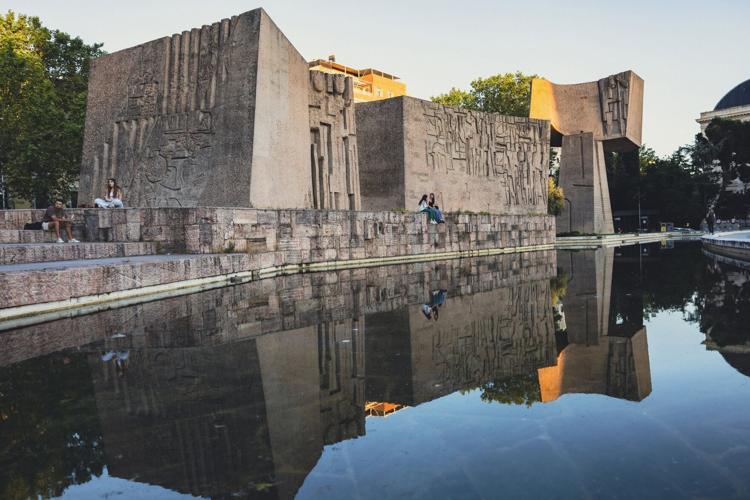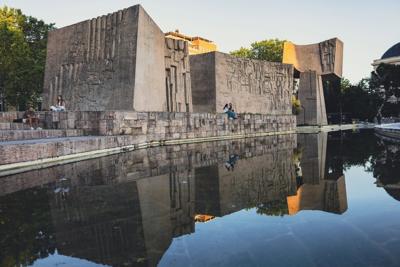More than 450 years ago, King Philip II of Spain decreed Madrid, a somewhat sleepy mountain town in the middle of the Iberian Peninsula, the capital of his empire. Many historians consider it an odd decision for a ruler whose maritime empire extended across three oceans and five continents and was connected by the largest navy the world had ever seen. Not only is Madrid 220 miles from the nearest Spanish port in Valencia on the Mediterranean, but itŌĆÖs also 2,000 feet above sea level. A bustling seafaring city, such as C├Īdiz, would have been a more obvious choice.
And given todayŌĆÖs tourism-driven economy in a country that visitors associate with sunshine and beaches, MadridŌĆÖs lack of a sea coast might seem an even greater handicap than it was for Philip.
But the cityŌĆÖs role as the centre of a once vast maritime realm has eternally linked it with the sea in myriad ways.
Museums, food, massive anchors and beaches.
HereŌĆÖs a guide to MadridŌĆÖs seaworthy treasures.
LetŌĆÖs start with the god of the seas. In the heart of the city, on the Paseo del Prado ŌĆö it’s just steps from City Hall and MadridŌĆÖs great art venues such as the Prado and the Thyssen-Bornemisza ŌĆö stands a towering and rather hunky 1780s statue of Neptune wielding his trident in a multitiered circular fountain. He appears to be arriving in town on a chariot made of shells, pulled from the frothy depths by sea horses and dolphins. ItŌĆÖs a beloved local monument and the de facto gathering spot for one of MadridŌĆÖs two soccer teams (Atl├®tico de Madrid) after big wins.
Neptune is far from the only seafarer in the city. Parks and plazas are littered with monuments and mementos of famous navigators, admirals, captains, sea battles and an astonishing number of massive anchors. Tritons and dolphins abound in fountains in Retiro Park and in the grand Plaza de la Rep├║blica Argentina, where life-size bronze dolphins leap, leading locals to refer to it as the ŌĆ£plaza of the dolphins.ŌĆØ
Street names include Calle del Almirante (Admiral Street) and Calle del Barco (Boat Street), as well as ones honouring explorers, such as Nu├▒ez de Balboa and Juan Sebasti├Īn de Elcano, and naval heroes like ├ülvaro de Baz├Īn and Blas de Lezo. Both a street and a plaza bear the name De la Marina Espa├▒ola and theyŌĆÖre nowhere near each other. ThereŌĆÖs even an altar in the shape of a boat in the parish church Nuestra Se├▒ora del Carmen y San Luis.
Then, of course, thereŌĆÖs Christopher Columbus (Crist├│bal Col├│n in Spanish), who was in the employ of SpainŌĆÖs Queen Isabel of Castile in 1492 when he accidentally bumped into the Americas. Plaza de Col├│n is among the cityŌĆÖs busiest public spaces. A statue of the man himself stands atop a gothic-style pedestal in the centre of a swirling 20 lanes of traffic on the Paseo de la Castellana, MadridŌĆÖs grandest thoroughfare.
The neighbouring plaza hosts several naval monuments (naturally with an anchor or two), but none are more imposing than the ŌĆ£Monument to the Discovery of America,ŌĆØ four hulking Brutalist cast-concrete forms designed by Joaqu├Łn Vaquero Turcios and engraved with figures and phrases from officers, sailors and others related to the voyage, which face Calle Serrano. You may love them or hate them. You canŌĆÖt miss them.
For a deep dive into Spanish maritime adventure, look no farther than the Naval Museum, which shares pride of place along the Paseo del Prado with the cityŌĆÖs great museums and sits next to the headquarters of the Spanish Armada, itself a dramatic revivalist building adorned with maritime motifs.
The museum reopened in 2022 with a new entrance made of wood that creaks like a pitching ship. Among its treasures are Juan de la CosaŌĆÖs 1500 map of America. ItŌĆÖs breathtaking to stroll among the glorious skylit galleries packed with model ships ŌĆö some of them are almost big enough to board ŌĆö elaborately carved shipsŌĆÖ figureheads, hand-painted battle flags, depictions of famous naval battles, as well as countless sextants, cannons and torpedoes. ItŌĆÖs especially appealing to children.
Other museums also offer salty breezes: the Thyssen-Bornemisza Museum has a vast collection of seascapes, from the frolicking 1691 ŌĆ£Neptune and Amphitrite,ŌĆØ by Sebastiano Ricci, to the dramatic naval battles of Dutch masters such as Willem van de Velde and CanalettoŌĆÖs nearly photographically detailed images of Venice.
The Prado has its share of maritime masterpieces, including colourful beach scenes by Joaqu├Łn Sorolla. There are more sun-kissed Sorollas and other seascapes at the Real Academia de Bellas Artes de San Fernando, which also houses a copy of the famous 1656 map of Madrid by Pedro Teixeira.
As the kings of Spain chose not to live by the sea, the sea was brought to them; several royal palaces feature facilities for floating ships. Besides the Estanque Grande, where modern madrile├▒os and tourists now ply the waters in rowboats, thereŌĆÖs the artificial lake in the Casa de Campo park adjacent to the Royal Palace. Back in the day, new naval technologies and battle plans could be tested, but one senses that these man-made bodies of water were mostly for the kingsŌĆÖ amusement: naval war games with miniature flotillas, the pageantry of royal boat parades.
The most famous of these parades took place at the Royal Palace of Aranjuez on the Tajo River about 40 minutes south of Madrid. Elaborate barges, some made in Venice and Naples and covered with gilded sculptures and plush fabrics, would be taken out on the river for royal diversion. For a melancholy King Philip V, and later his son, Ferdinand VI, the famous Italian castrato, Farinelli, was charged with staging elaborate floating entertainments on the Tajo, often featuring Farinelli singing arias amid fireworks and as many as 60,000 candles.
Today, the royal barges, known as fal├║as, can be seen in a small museum in the palaceŌĆÖs gardens, full of exotic trees brought on ships from around the empire.
While the extravagance of FarinelliŌĆÖs river rides are out of reach for most of us, a small tour boat, El Curiosity, leads 45-minute tours on the Tajo in Aranjuez that give a sense of royal history while passengers enjoy the languorous pace of the riverŌĆÖs passage through this UNESCO World Heritage site (9.99 euros, or $16, reservations recommended).
For many, MadridŌĆÖs most relevant marine treasures are the ones that turn up on a plate. Improbably, landlocked Madrid is SpainŌĆÖs principal seafood exchange and ranks among the largest in the world, second only to Tokyo. Spanish expressions abound to express the extraordinary quality and diversity of seafood from all over the country. There are pulperias ŌĆö these are octopus restaurants ŌĆö from Galicia; anchovy restaurants from Cantabria; and restaurants such as La Trainera, founded in 1966, that could offer a graduate program in Spanish shellfish.
For a newer version of the seafood bonanza, try Estimar, Desde 1911 or Bistronomika. Restaurant St James offers exquisite paellas ŌĆö these are typical seaside fare ŌĆö in its nautical-themed dining room and terrace. Then there are local favourites such as El Yate, or Milford, where the decor sails right past nautical to full-on yacht club.
Perhaps nothing underscores MadridŌĆÖs improbable link to the sea than the fact that its most iconic, must-eat-in-Madrid food, is a bocata de calamares, a simple sandwich of fried calamari. Everyone has their favourite, but the current reigning temples are Hermanos Vinagre and Arima.
This article originally appeared in .































To join the conversation set a first and last name in your user profile.
Sign in or register for free to join the Conversation